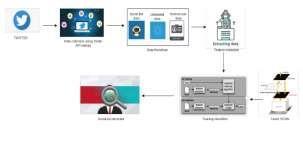
3 minute read
FEATURE PREPROCESSING
Volume: 08 Issue: 06 | June 2021 www.irjet.net p-ISSN: 2395-0072
evaluate results based on three different metrics: Precision, Recall, and F1 Score (F1 is the harmonic average of Precision and Recall, F1 = 2 ·
Advertisement
Precision·Recall Precision+Recall). In the meantime, we use Accuracy as a metric and compare it with the SVM algorithm to verify the efficiency of the method. Accuracy is the ratio of the number ofsamples correctly classified by the classifier to the total number of samples.
In [10] Rashmi Ranjan Rout,Greeshma Lingam, and D.
V. L. N. Somayajulu (2019) This article presents an LAMSBD algorithm by integrating a trust computational model with a set of URL-based features for MSBD. In addition, we evaluate the trustworthiness of tweets (posted by each participant) by using the Bayesian learning and DST. Moreover, the proposed LA-MSBD algorithm executes a finite set of learning actions to update action probability value (i.e., probability of a participant posting malicious URLs in the tweets). The proposed LA-MSBD algorithm achieves the advantages of incremental learning. Two Twitter data sets are used to evaluate the performance of our proposed LAMSBD algorithm. The experimental results show that the proposed LA-MSBD algorithm achieves up to 7% improvement of accuracy compared with other existing algorithms. For The Fake Project and Social Honeypot data sets, the proposed LA-MSBD algorithm has achieved precisions of 95.37% and 91.77% for MSBD, respectively. Furthermore, as a future research challenge, we would like to investigate the dependence among the features and its impact on MSBD.
4. PROPOSED METHODOLOGY
To overcome the restrictions of techniques we have introduced the deep learning technique dependent of Faster RCNN and RNN Using Twitter API we can post tweets includinghash tag for particular topic. We generate Twitter data set to differentiate between human and bots. The tweets can be postedby registered users or by computer program. Computer programs are designed in such a way that they continuously tweet from some account on particular topic on behalf or against it for some neutral tweets. Usually when normal users tweet or reply to a particular topic the frequency of tweets will be normal. We will train the data sets using RCNN based algorithm. The input will be processed using RCNN to find out the sentiments. To detect if it is a human generated or not we will check the time interval ofthe Accounts suppose its within 10 minutes. If it is more than 8-10 minutes then it was suspected. We will also analyze the type of treats that has been posted from a user account. In the course of identification of human account deception large corpus of data is obtained. This data is recycled since it will contain information that do not contribute to the end results. The data is mined, impure data is removed and then stored in a database. This data is applied to machine learning models and results are obtained. Our proposed approach for detecting malicious social bot in twitter network using deep learning was modelled in five modules
1. Acquisitionand Profiling setup
2. DataBootstrap
3. FeatureExtraction
4. FeaturePreprocessing
5. TrainingClassifiers.
Our model is suitable to any online social network such as twitter,Acquisition step can be adapted according to twitter API-Tweepy. Classification step is also flexible. In this work we adopted FASTER REGIONS CONVOLUTION NEURAL NETWORK and RESNET which is reported good results by applying in big data environments that treats specifically bots on online social network such as twitter. The proposed approach pipeline: Acquisition and Profiling Setup, Data Bootstrap Feature Extraction, Feature Preprocessing and Classification. Each user, we need to create a user profile. The labelling followed the rules consolidated in related works:
—Malicious bots: automated accounts with spamlike content, usually redundant and repetitive;
—Legitimate bots: automated accounts with harmless content, usually posted with the use of auxiliary software;
—Human: non-automated accounts with intelligent and original content.
Fig 1: proposed framework
1. ACQUISITION AND PROFILING SETUP
The acquisition step consistsof getting data from an OSN to create a textual data set. Our model requires the collected textual set to be grounded on one main subject .This is requirement is necessary, because wavelet-based text mining takes analysis of signalized key terms to obtainany further knowledge. In case the dataset is not grounded on one main term, we suggest the extraction of relevant terms. Theuse of a supervised deep-learning approach, we need a l dataset to induce a method. The text of each user is concatenated cumulatively following the profile-based



